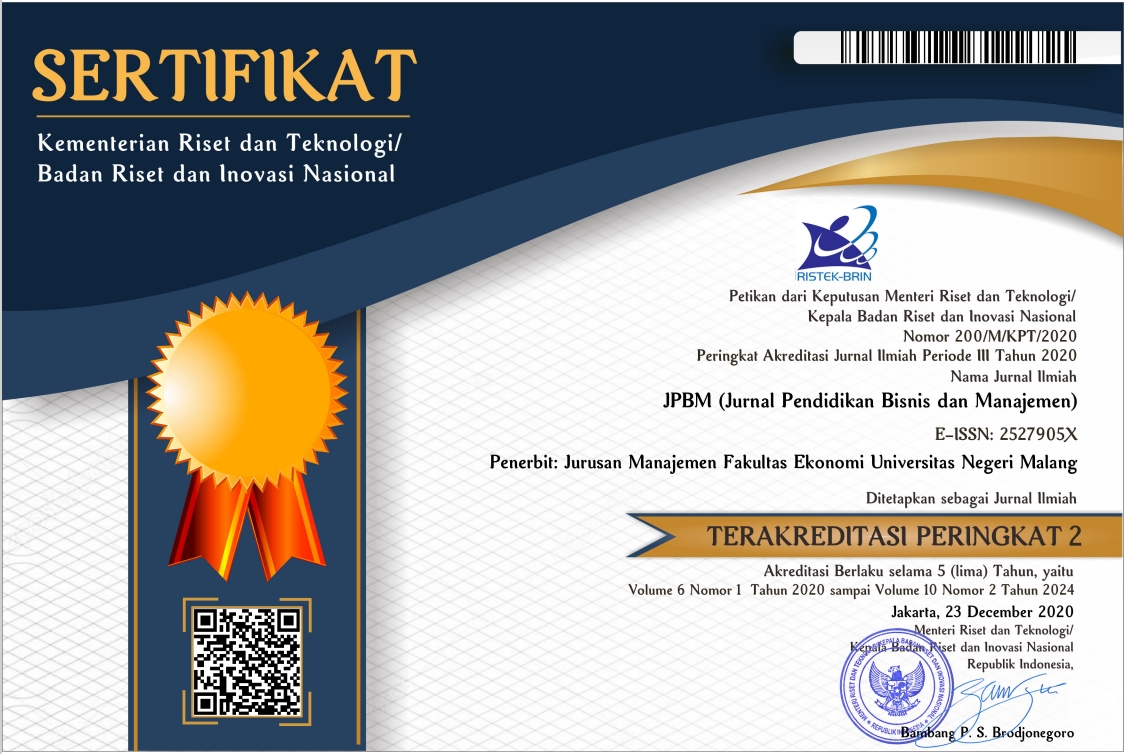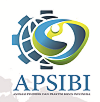Financial Inclusion as Mediator in the Relationship of Social Capital and Financial Literacy Towards Business Performance
Abstract
This study examines the performance problems of SMEs in the trade sector in Pekanbaru by using several internal company factors to build a competitive strategy. The study involved 300 SMEs consisting of 26 wholesalers and 274 retailers in Pekanbaru, Riau. This research adopted a structural equation model (SEM) approach with AMOS for hypothesis testing. The results indicate that social capital and financial literacy have a significant direct effect on the performance of the SMEs businesses in the trade sector in Pekanbaru. It implicates that social capital and financial literacy are two determining factors for the success of SMEs businesses. However, social capital does not affect business performance indirectly through the role of financial inclusion. Meanwhile, financial literacy in this study, directly or indirectly, through financial inclusion can improve the performance of SMEs businesses. This study shows that SMEs in the trade sector in Pekanbaru must continue to foster partnerships with existing associations, and they also need to be directed so as not to deviate from the common goal of advancing the SMEs businesses.
Keywords: Financial Literacy, Financial Inclusion, SMEs’ Business Performance, Social Capital
Full Text:
PDFReferences
Atkinson, A., & Messy, F. (2012). Measuring financial literacy: Results of the OECD/ International network on financial education (INFE) pilot study [working paper n. 15]. OECD Publishing.
Bongomin, G. O. . (2017b). The relationship between access to finance and growth if smes in developing economies: Financial literacy as a moderator. International Business and Strategy Journal, 27(4), 520–538.
Bongomin, G. O., Ntayi, J., Munene, J., & Nabeta, I (2016). Social capital: Mediator of financial literacy and financial incluaion in rural Uganda. International Business and Strategy Journal, 26(2), 291–312.
BPS. (2020). Pendapatan Nasional Indonesia 2015-2019. Badan Pusat Statistik.
Cendani, C., & Tjahjaningsih, E. (2015). Pengaruh employee engagement dan modal sosial terhadap kinerja karyawan dengan OCB (Organizational Citizenship Behaviour) sebagai mediasi (Studi pada Bank Jateng kantor pusat). Media Ekonomi dan Manajemen, 30(2), 149–160.
Claridge, T. (2004). Social capital and natural resource management: An important role for social capital? In University of Queesland (Issue July).
Cole, S., Sampson, T., & Zia, B. (2011). Financial decisions, and the demand for financial services: evidence from India and Indonesia, Working Paper 09 117, Harvard Business School, Harvard University and the World Bank, Washington, DC.
Dahmen, P., & Rodríguez, E. (2014). Financial literacy and the success of small businesses: An observation from a small business development center. Numeracy, 7(1), 3-14.
Dermawan, T. (2019). Pengaruh literasi, inklusi dan pengelolaan keuangan terhadap kinerja dan keberlanjutan UMKM (Studi pada pelaku usaha mikro mahasiswa Universitas Brawijaya) (Doctoral dissertation, Universitas Brawijaya).
Doi, Y., McKenzie, D., & Zia, B. (2014). Who you train matters: Identifying combines effects of financial education on migrant households. Journal of Development Economics, 2(2), 39–55.
Eke C. E., & Raath, C. (2013). SMME owners’ financial literacy and business growth. Journal of Social Sciences MCSER Publishing, Rome-Italy, 4(13), 397–406.
Fatoki, O. (2014). The financial literacy of micro entrepreneurs in South Africa. Journal of Social Science, 40(2), 151–158.
Gavrea, C., I, L., & Roxana, S. (2011). Determinants of organizational performance: the case of Romania. Management and Marketing Challenges for the Knowledge Society, 6(2), 285–300.
Ghozali, I. (2017). Model persamaan struktural, konsep dan aplikasi dengan program AMOS 24. Badan Penerbit Universitas Diponegoro.
Gunday, G., Gunduz., U., Kemal, K., & Lutfihak, A. (2011). Effects of innovation types on firm performance. Int. J. Production Economics, 133, 662–676.
Guo, H., Yang, Z., Huang, R., & Guo, A. (2020). The digitalization and public crisis responses of small and medium enterprises: Implications from a COVID-19 survey. Frontiers of Business Research in China, 14(1), 1-25.
Hair, J. F. J., Anderson, R. E., Tatham, R. L., & Black, W. C. (1998). Multivariate data analysis (Fifth edit). Prentice Hall Internatiional, inc.
Hartono, R., & Soegianto, E. (2013). Analisis pengaruh modal sosial dan orientasi kewirausahaan terhadap kinerja kewirausahaan pada PT. Mentar I Esa Cipta. Jakarta:Binus University.
Hudson, M., Smart, A., & Bourne, M. (2001). Theory and practice in SME performance measurement systems. International Journal of Operations &Production Management, 21(8), 1096–1115.
Khoirrin, L., & Kartika, L. (2014). Pengaruh modal insani dan modal sosial terhadap kinerja (Studi kasus usaha kecil dan menengah (UKM) makanan dan minuman Kota Bogor). Jurnal Manajemen dan Organisasi, 5(3), 244–257.
Klapper, L., A, L., & Oudheusden, P. V. (2015). Financial literacy around the world. in standard & poor’s ratings services global financial literacy survey (GFLEC working paper).
Kumar, N. (2013). Financial inclusion and its determinants : Evidence from India. Journal of Financial Economic Policy, 1(5), 4–19.
Lusardi, A., & Mitchell, O. S. (2007). US household savings behavior: The role of financial literacy, information and financial education programs, in Foote, C., Goette, L. and Meier, S. (Eds), Policymaking Insights from Behavioural Economics, Federal Reserve Bank of Boston, Boston, MA, pp.
Lusardi, A., & Mitchell, O. S. (2014). The economic importance of financial literacy: Theory and evidence. Working Paper of the TIAA-CREF Institute.
Lusardi, A., & Mitchell, O. S. (2011). Financial literacy and planning; Implications for retirement well being. National Bureau of Economic Research.
Muniady, R., Mamun, A., Mohamad., A. A. R., Permarupan, M. Y., & Zainol, B. N. (2015). The effect of cognitive and relational social capital on structural social capital and micro-enterprise performance. SAGE Open, 5(4).
Mwangi, I. W., & Ouma. S. A. (2012). Social capital and access to credit in Kenya Research and Policy Analysis Department , Central Bank of Kenya.
Nahapiet, J., & Ghoshal, S. (1998). Sosial capital, human capital and organizational advantage. Nonaka & Takeuchi, 23(2), 242–266. https://doi.org/10.2307/259373
Nunoo, J., & Andoh, F. . (2012). Sustaining Small and medium enterprises through financial service utilization: Does fnancial literacy matter? International Journal of Economic and Financial, 49(3), 31–40.
OECD. (2013). The Role of Financial Education in Financial Inclusion: OECD / INFE Evidence, Policies and Illustrative Case Studies. Moscow : G20 Communiqué Meeting of Finance Ministers and Central Bank Governors.
Oliveira, J. (2013). The influence of the social capital on business performance: an analysis in the context of horizontal business networks. Revista de Administração Mackenzie, 14(3), 209–235.
Prasetyo, T., & Harjanti, D. (2013). Modal sosial pengusaha mikro dan kecil sektor informal dan hubungannya dengan kinerja bisnis di wilayah Jawa Timur. Agora, 1(3), 12-24.
Putri, N. M., & Rahyuda, H. (2017). Pengaruh tingkat financial literacy dan faktor sosiodemografi terhadap perilaku keputusan investasi individu. E-Jurnal Ekonomi dan Bisnis Universitas Udayana, 6(9), 3407–3434.
Remund, D. L. (2010). Financial Literacy Explicated: The Case For A Clearer Definition In An Increasingly Complex Economy. The Journal of COnsumer Affairs, 44(2), 276–290.
Sajuyigbe, & Ademola, S. (2017). Influence of financial inclusion and social inclusion on the performance of women-owned businesses in Lagos State. Scholedge International Journal of Management & Development, 4(3), 18–27.
Shankar, S. (2013). Financial inclusion in India : Do microfinance institutions address access barriers? Journal of Entrepreneursip Perspectives, 2(1), 60–74.
Simeyo, O., Lumumba., Nyabwanga., R. N., Ojera, P., & Odondo, A. J. (2011). Effect of provision of microfinance on performance of micro enterprises : A study of youth micro-enterprises under kenya rural enterprise program (K-REP), Kisii County. African Journal of Business Management, 5(20), 8290–8300.
Sitharam, S., & Hoque, M. (2016). Factors affecting the performance of small and medium enterprises in KwaZulu-Natal, South Africa. Problems and perspectives in Management, 14(2), 277-288.
Sugiyanto, E. K., & Marka, M. M. (2017). Modal sosial dan human capital sebagai alat untuk meningkatkan kinerja pemasaran. Jurnal Manajemen dan Kewirausahaan, 5(2), 36–42.
Sugiyono. (2017). Metode penelitian kuantitatif, kualitatif, dan rand. Alfabeta. Bandung.
Terzi, N. (2015). Financial inclusion and Turkey. Academic Journal of Interdisciplinary Studies, 4(1), 269–276.
Tristiyani, L. (2019). Peran social capital dalam memoderasi financial literacy dan financial inclusion terhadap kinerja keuangan. Undergraduate thesis, Universitas Islam Sultan Agung.
Tsalitsa, A., & Rachmansyah, Y. (2016). Analisis pengaruh literasi keuangan dan faktor demografi terhadap pengambilan kredit pada PT. Columbia Cabang Kudus. Media Ekonomi dan Manajemen, 31(1), 1-12.
Wang, Z., & Nianxin, W. (2012). Knowledge sharing, innovation and firm performance. Expert Systems with Applications, 39, 8899–8908.
Warmana, G. ., & Widnyana, I. W. (2018). Pengaruh modal sosial terhadap kinerja usaha pada UD. Udiana ds. Celuk, Gianyar Bali. Jurnal Ekonomi dan Pariwisata, 13(1), 27–34.
Yilmaz, C., Alpkan., L., & Ergun, E. (2005). Cultural determinants of customer and learning-oriented value systems and their joint effects on firm performance. Journal of Business Research, 58(10), 1340–1352.
Refbacks
- There are currently no refbacks.
JPBM (Jurnal Pendidikan dan Bisnis Manajemen) is licensed under a Creative Commons Attribution-NonCommercial-ShareAlike 4.0 International License.
JPBM (Jurnal Pendidikan dan Bisnis Manajemen) is abstracted and indexed in :
















